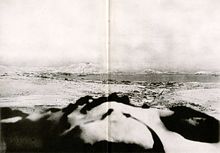28 cm howitzer L/10
| 28 cm Howitzer L/10 | |
|---|---|
 A 28 cm howitzer during the siege of Port Arthur. | |
| Type | Coastal artillery, Heavy Siege Howitzer |
| Place of origin | Empire of Japan |
| Service history | |
| In service | 1892-1945 |
| Used by | Imperial Japanese Army |
| Wars | Russo-Japanese War, Second Sino-Japanese War |
| Production history | |
| Designer | Krupp |
| Manufacturer | Osaka Artillery Arsenal |
| No. built | 220 |
| Specifications | |
| Mass | 10.758 tonnes (10.588 long tons; 11.859 short tons) |
| Barrel length | 2.863 m (9.39 ft) (L10.2) |
| Shell | Bag charge |
| Shell weight | 217 kg (478 lb) |
| Caliber | 280 mm (11 in) |
| Breech | Horizontal sliding-block |
| Carriage | Box |
| Elevation | -10° to +68° (firing) |
| Traverse | 360° |
| Muzzle velocity | 314 m/s (1,030 ft/s) |
| Maximum firing range | 7,800 m (8,500 yd) |
The 28 cm Howitzer L/10 (二十八糎榴弾砲, nijūhachi-senchi ryūdanhō) was a Japanese coastal and siege howitzer. It was developed by Krupp before 1892 and saw service in the Russo-Japanese War during the siege of Port Arthur and the Second Sino-Japanese War.
Design and description
The 28 cm Howitzer L/10 was a design of Krupp but some 220 pieces were manufactured by the Osaka Artillery Arsenal for Japanese coastal defence.[1] It was mounted on a turntable which was fixed to a steel firing platform. It required two to four days to emplace for firing. An ammunition crane was fixed to the carriage for ease of loading as can be seen in the image above. The howitzer entered service in 1892 and was installed in shore batteries in forts overlooking Tokyo Bay and Osaka Bay, and had been intended for anti-ship operations. However it saw use as a siege gun during the Russo-Japanese War due to the lack of heavy siege guns.
It fired a 217 kg (478 lb) high-explosive shell to a range of 7,800 metres (8,500 yd).[2]
Combat history
Russo-Japanese War

During the Russo-Japanese War the Japanese Third Army was besieging Port Arthur. While the capture of Port Arthur had been achieved in a single assault during the First Sino-Japanese War the situation was different in 1904. The Russians had been in possession of Port Arthur since 1897 and had constructed strong fortifications around the city following the plans of General Eduard Totleben. After the first general assault in August 1904 and over 16,000 casualties General Nogi, the commanding officer of the Japanese forces, requested heavy siege guns. With the arrival of the first battery of 28 cm howitzers, replacing those lost when the transport Hitachi Maru, loaded with a battalion of the First Reserve Regiment of the Guards, was sunk by Russian cruisers in the Hitachi Maru Incident on June 15, 1904 the situation changed. The massive 11-inch howitzers could throw a 217 kilogram (478 pound) shell over 7.8 kilometers (4.8 miles), and Nogi at last had the firepower necessary to make a serious attempt against the Russian fortifications. The huge shells were nicknamed "roaring trains" by the Russian troops (for the sound they made just before impact), and during their period at Port Arthur over 16,949 of these shells were fired.[3]


Finally, at 10:30 on December 5, following another massive artillery bombardment, the Japanese managed to overrun 203 Meter Hill overlooking the harbour of Port Arthur with the Russian Pacific Fleet at anchor. They send Artillery observer on the hill, directing the fire of the 28 cm howitzer destroying systematically the Russian fleet, one ship after another. On December 5, 1904, the battleship Poltava was destroyed, followed by the battleship Retvizan on December 7, 1904, the battleships Pobeda and Peresvet and the cruisers Pallada and Bayan on December 9, 1904. The battleship Sevastopol, although hit 5 times by 11-inch (280 mm) shells, managed to move out of range of the guns. On the night of January 2, 1905, after Port Arthur surrendered, Captain Nikolai Essen of the Sevastopol had the crippled battleship scuttled in 30 fathoms (55 m) of water by opening the sea cocks on one side, so that the ship would sink on its side and could not be raised and salvaged by the Japanese.
Second Sino-Japanese War
In November 1939 during the Second Sino-Japanese War 28 cm howitzers were deployed at the Yellow River where they put a railway tunnel out of action for over three months.[4]
World War II
Due to a lack of alternatives the Japanese reactivated the 28 cm howitzer for coastal defence in 1945, expecting the landing of the Allies. 13 guns were in use on Kyushu, 6 on Shikoku, 62 on Honshu and 10 on Hokkaido.[5]
References
- Kowner, Rotem. Historical Dictionary of the Russo-Japanese War. Scarecrow, 2006 ISBN 0-8108-4927-5.
- Zaloga, Steven. Defense of Japan 1945. Osprey Publishing,2010 ISBN 9781-8460-3687-3.
External links
- Website about 28-cm-Howitzer, English
- Website about 28-cm-Howitzer in World War II, Japanese
